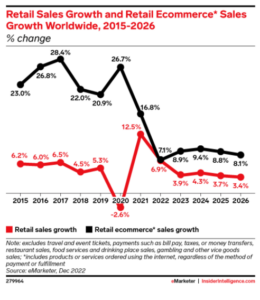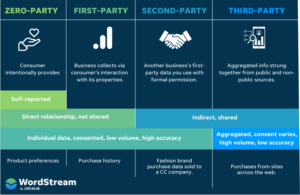Looking for ways to increase your ecommerce profits in 2023? Look no further and read on!
Customers have rediscovered the joy of exploring shopping malls on leisurely weekends.
But as an eCommerce retailer, does that make you skeptical about the possibility of brick-and-mortar stores making a surprising comeback, challenging the dominance of eCommerce?
Well, some numbers do point towards shifting consumer behavior.
As per Global Retail Ecommerce Forecast 2023:
The retail eCommerce sales growth sees a slowdown, with only 8.9% projected increase this year, a notable decline from the previous years’ double-digit growth rates of 26.7% and 16.8%.

Furthermore, lingering inflation and recession squeeze on people’s finances, causing them to make careful spending decisions. Of course, its impact can be different for different product categories. Jungle Scout Cobalt data reveals that while shoppers are reducing their spending in certain areas, they are maintaining or even increasing it in other aspects.
In fact, the scenario isn’t all bleak! There is no no-growth, just slower growth.
If viewed through the lens of opportunity, the 8.9% of retail eCommerce sales growth in 2023 is still an improvement from the 7.1% growth in 2022 and presents a favorable landscape for businesses to seize upon.
And this could be the perfect time to embrace the slowdown—time to enhance your online business, optimize costs, amp up online sales strategies, and seize growth opportunities to increase your ecommerce profits.
That’s why we’ve got some strategies eCommerce brands can use to improve the health of their bottom line and increase your ecommerce profits in 2023.
Let’s get started.
Top 5 Strategies to Drive Ecommerce Profitability in 2023
1. Meet the Customers’ High Expectations with Personalization
In retail, it’s no secret that the better the customer experience, the bigger the splurge! And let’s not forget; happy customers are repeat customers.
Easier said than done, though.
Customer expectations are on rise due to the convenience and quality offered by eCommerce giants. Seventy-two per cent of customers want immediate service. Meeting those expectations may seem effortless if you’re Bezos, but it becomes a challenge for average eCommerce store owners.
Enter personalized online shopping experiences.
A personalized shopping experience refers to the customisation of the shopping journey. It helps your brand meet individual customers’ specific preferences, needs, and interests.
The biggest advantage of delighting customers with a tailored shopping experience is that it instills purchase confidence in them, effectively converting more casual browsers into loyal buyers.
In short, forget the masses; focus on individual relevance!
Brick-and-mortar retailers have always been aware of the power of personalization. And they have the advantage of providing sensory experiences that online stores can’t replicate: the ability to touch, taste, and smell products and the warm greeting from a sales associate when one walks in.
However, just as a skilled sales rep in a store understands a customer’s interests, online brands, too, can create personalized journeys across multiple touchpoints and offer a similar tailored experience. Here’s how-
1. Zero and First-Party Data Collection
Ecommerce marketers need data to personalize. Collecting customer data helps you build genuine relationships, and communicate meaningfully.
So far, third-party cookies have been the holy grail for brands to do so. But not any more!
Google is planning to migrate 1% of Chrome users to Privacy Sandbox in early 2024. It will disable third-party cookies for that segment.
Hence, instead of relying on easily accessible third-party cookies, brands now have to seek direct engagement with customers to gather valuable insights. This new data collection strategy is zero-party and first-party data.
To the unversed, zero-party data is the data customers willingly give to brands. First-party data is the behavioral information that a brand collects as customers interact with their websites, social media, or app.

Anyways, how can brands obtain it? By offering customers promotions and benefits in exchange for their data.
Some fun ways of zero and first-party data Collection are:
- Quizzes
- Conversational pop-ups
- Surveys
- Subscriptions
- Accounts and registration
2. Omnichannel Personalisation
Customers today crave seamless experiences across multiple channels. It has led eCommerce brands to respond with expanded personalization efforts, connecting at every touchpoint. That’s omnichannel personalization.
“Omnichannel” is more than just a buzzword; it signifies seamless and tailored experiences wherever customers engage. This holistic approach spans mobile, social media, websites, apps, and email, to connect with consumers at every touchpoint.
Again, omnichannel personalization requires a constant flow of customer information across channels to ensure a comprehensive understanding of customers.
Contrary to popular belief, omnichannel personalization doesn’t have to be costly. With tools like Google Analytics, brands can easily implement customer journey mapping and create customer profiles without breaking the bank.
Key components of omnichannel personalization are:
- Marketing automation using tools like Klaviyo, Drip, etc.
- Customer data collection using tools like Optimizely.
- Multichannel analytics to track performance across different channels.
- Multichannel order management system.
- Social media integrations to automate the import of user-generated content on eCommerce sites.
- Mobile apps with augmented and virtual reality features.
2. Scale Your Supply Chain Logistics
Amidst a growing number of sellers diluting the market, the onus is on each brand to highlight why customers should choose them. Ecommerce logistics is one of the reasons.
No wonder optimizing the eCommerce logistics process and preparing it to handle an influx of online orders is non-negotiable. Online retailers must adopt a forward-looking strategy to manage delivery operations that exceed customer expectations.
That said, eCommerce logistics can be a resource-intensive challenge. Ensuring smooth eCommerce order fulfillment, regardless of the customer’s location, requires careful planning and execution. Here’s what you can do:
1. Micro-Fulfilment for the Last Leg
The last-mile delivery—where the product lands in the customer’s hand, holds immense importance for online retailers in providing a satisfying customer experience.
A superior last-mile journey engages customers and motivates them to spend more. In fact, three-quarters of customers are willing to increase their spending if they are pleased with the delivery services received.
While this is good news, last-mile delivery is the most complex and costly part of the supply chain, accounting for 40-55% of total supply chain costs.
But online businesses can tackle the rising costs of last-mile delivery head-on by taking matters into their own hands through micro-fulfilment.
Micro-fulfillment is a cutting-edge approach that involves setting up small-scale and automated warehouses in convenient urban areas near the end consumer.
With a micro-fulfilment center (MFC), you can cut down the distance between customers and their ordered items. Regionalising inventory can effectively reduce the need for shipping from regional or central distribution centers to local distribution centers. It can save a lot of dollars while still ensuring faster last-mile delivery.
For instance, partnering with a 3PL in the same area as the target market allows you to store the inventory there. So that customers can avail the convenience of free or same-day delivery.
2. Find the Right 3PL Partner Early
Ecommerce brands are increasingly turning to third-party logistics (3PL) providers due to the limitations of handling all operations in-house.
This is especially true for eCommerce fulfillment, where the demands of growing online businesses often outpace their resources. Operating on limited budgets, these businesses discover that partnering with a 3PL can save cost and time, enabling them to focus on growth and customer satisfaction.
Typically, 3PLs offer full-range eCommerce fulfillment services— warehousing, order processing, shipping, receiving, etc. Many 3PL warehouses also provide additional offerings like customer support, returns processing, and customization options.
Outsourcing to a 3PL grants you access to specialized capabilities, round-the-clock support, and expanded expertise that may be otherwise unattainable for individual businesses. Moreover, it offers cost benefits as 3PLs often leverage economies of scale, resulting in better unit costs than in-house operations.
By partnering with a 3PL, you can leverage various services to streamline your logistic operations and increase your ecommerce profits.
3. Expand into New Markets
The global economy has allowed eCommerce brands to transcend borders and reach a broader customer base like never before.
While expanding into new markets may not be a wise option in the early stage, there comes the point where growth within the current target market plateaus. That’s when moving into global markets becomes essential for continued growth and an increase in your ecommerce profits.
Of course, you’ll need resources and tools for expansion. But considering the benefits of a wider customer base on earning potential, cross-border eCommerce can be highly worthwhile for entrepreneurs.
Here are some key things to consider for tapping into the growing market:
1. Get a Good Idea of Your Niche Audience
As you venture into new markets, redefining your customer avatar becomes crucial. It includes your global customers’ needs, interests, demographics, and preferences.
You gain valuable insights for shaping your marketing strategy by redefining your customer avatar. Essentially, it prepares you better to cater to the unique preferences of your global customers.
2. Put Automation to Good Use
As you enter new markets, automation becomes more relevant. Taking care of the menial tasks makes merchants more efficient and saves costs.
Inventory and order management, warehousing, email marketing, and social media scheduling are some aspects of running an online store that can be automated and freeing-up valuable time for high-level planning.
Even still, you’ll have to be thorough with your research to avoid unnecessary expenses or redundant systems.
4. Expand Product Range and Pricing
Expanding your product range allows you to tap into the full potential of your existing audience while attracting new customers. Adding new products to your offerings is also an easy way to maximize reach and capture more attention to increase your ecommerce profits.
It can be done in different ways. You can introduce more color options, additional sizes, and diverse styles to cater to a wider customer base. If you operate in multiple regions, customize your product offerings to suit the preferences and demands of each specific country.
You can also combine it with a reexamination of your existing product line-up. It’ll be a great way to identify and remove underperforming items.
With product line-up expansion, you can:
- Tap into untapped customer segments.
- Unlock cross-selling opportunities.
- Increasing Average Order Values (AOV).
- Increase your ecommerce profit margins using long-tail products.
However, for products to bring in significant profits, it’s crucial to reassess your pricing strategies. Hence, you must consider factors such as cost structure and competitor prices when determining your pricing strategy. Regularly evaluating and adjusting your pricing approach will help you balance profitability and market competitiveness.
5. Harness the Power of Micro-Influencers on Social Media
While influencer marketing has boomed in recent years, brands are questioning its value due to its big bucks spending and unreliable results. For smaller brands, investing in a digital superstar can be impractical.
Off late, increasingly brands are turning to micro-influencers. An influencer with a follower count of 10,000–100,000 followers is a micro-influencer.
But why go with micro-influencers to grow your eCommerce business?
- With their smaller but highly engaged following, they often achieve engagement on a peer-to-peer level compared to macro-influencers.
- People are more likely to value their recommendations as they are seen as more authentic.
- It comes at a lower cost compared to collaborating with celebrities or macro-influencers.
Having said that, brands often face difficulties in identifying influencers who align with their target audience, engagement levels, content, and brand voice.
So how to find the right influencer for your brand?
To begin your influencer search, manually search each social media platform where you intend to run your campaign. Use relevant keywords to search and then apply filters to focus specifically on user accounts. Review the profiles to find influencers who align with your brand’s mission and products.
Another thing you can do is explore your follower list or use a user-generated content tool. It will help spot people who are already talking about your brand, offering a convenient opportunity to initiate a partnership.
Lastly, consider partnering with an influencer agency if you have the budget.
Final Thoughts
As an eCommerce retailer, it’s vital to adapt to changing consumer behavior and leverage strategies to increase your Ecommerce profits in 2023. Embracing these strategies will position you to stay ahead in the evolving eCommerce landscape.
But that’s only half the job done.
Several key challenges can hinder growth and catch eCommerce businesses off guard. Manufacturing issues like slow response times, high cost of goods sold (COGS), and limited production capabilities can limit your progress. Additionally, managing inventory effectively, understanding reorder points, and identifying the most profitable products can be potential roadblocks.
Here’s the secret agent that connects all these aspects and empowers your business: bookkeeping.
Every facet of your online business is intricately linked to bookkeeping. Each element is crucial for your organization’s growth and success, from optimizing ad spending and hiring decisions to managing warehouse space.
Hence, it’s better to leave it to the experts!

EcomBalance, is the premier monthly bookkeeping service designed specifically for eCommerce businesses. Whether you sell on Amazon, Shopify, eBay, Etsy, WooCommerce, or other eCommerce channels, we’ve got you covered. Our specialized expertise ensures that your financial records are in perfect balance, giving you the peace of mind to focus on growing your business.
Interested in learning more? Book a call with our CEO, Nathan Hirsch.









